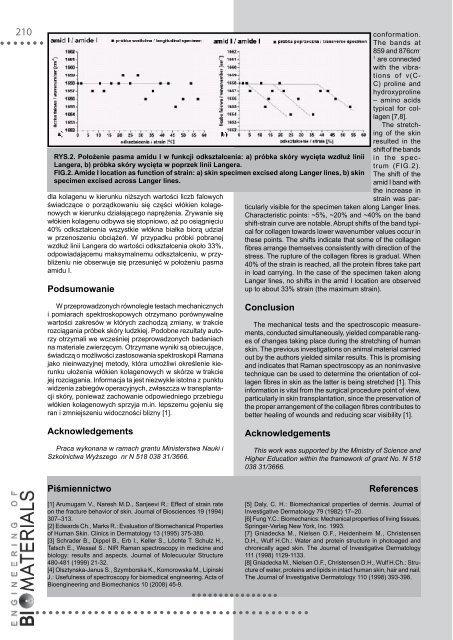89-91 - Polskie Stowarzyszenie Biomateriałów
89-91 - Polskie Stowarzyszenie Biomateriałów
89-91 - Polskie Stowarzyszenie Biomateriałów
Create successful ePaper yourself
Turn your PDF publications into a flip-book with our unique Google optimized e-Paper software.
210<br />
dla kolagenu w kierunku niższych wartości liczb falowych<br />
świadczące o porządkowaniu się części włókien kolagenowych<br />
w kierunku działającego naprężenia. Zrywanie się<br />
włókien kolagenu odbywa się stopniowo, aż po osiągnięciu<br />
40% odkształcenia wszystkie włókna białka biorą udział<br />
w przenoszeniu obciążeń. W przypadku próbki pobranej<br />
wzdłuż linii Langera do wartości odkształcenia około 33%,<br />
odpowiadającemu maksymalnemu odkształceniu, w przybliżeniu<br />
nie obserwuje się przesunięć w położeniu pasma<br />
amidu I.<br />
podsumowanie<br />
W przeprowadzonych równolegle testach mechanicznych<br />
i pomiarach spektroskopowych otrzymano porównywalne<br />
wartości zakresów w których zachodzą zmiany, w trakcie<br />
rozciągania próbek skóry ludzkiej. Podobne rezultaty autorzy<br />
otrzymali we wcześniej przeprowadzonych badaniach<br />
na materiale zwierzęcym. Otrzymane wyniki są obiecujące,<br />
świadczą o możliwości zastosowania spektroskopii ramana<br />
jako nieinwazyjnej metody, która umożliwi określenie kierunku<br />
ułożenia włókien kolagenowych w skórze w trakcie<br />
jej rozciągania. Informacja ta jest niezwykle istotna z punktu<br />
widzenia zabiegów operacyjnych, zwłaszcza w transplantacji<br />
skóry, ponieważ zachowanie odpowiedniego przebiegu<br />
włókien kolagenowych sprzyja m.in. lepszemu gojeniu się<br />
ran i zmniejszeniu widoczności blizny [1].<br />
acknowledgements<br />
Praca wykonana w ramach grantu Ministerstwa Nauki i<br />
Szkolnictwa Wyższego nr N 518 038 31/3666.<br />
conformation.<br />
The bands at<br />
859 and 876cm -<br />
1 are connected<br />
with the vibrations<br />
of ν(C-<br />
C) proline and<br />
hydroxyproline<br />
– amino acids<br />
typical for collagen<br />
[7,8].<br />
The stretching<br />
of the skin<br />
resulted in the<br />
shift of the bands<br />
in the spectrum<br />
(FIG.2).<br />
The shift of the<br />
amid I band with<br />
the increase in<br />
strain was particularly<br />
visible for the specimen taken along Langer lines.<br />
Characteristic points: ~5%, ~20% and ~40% on the band<br />
shift-strain curve are notable. Abrupt shifts of the band typical<br />
for collagen towards lower wavenumber values occur in<br />
these points. The shifts indicate that some of the collagen<br />
fibres arrange themselves consistently with direction of the<br />
stress. The rupture of the collagen fibres is gradual. When<br />
40% of the strain is reached, all the protein fibres take part<br />
in load carrying. In the case of the specimen taken along<br />
Langer lines, no shifts in the amid I location are observed<br />
up to about 33% strain (the maximum strain).<br />
ryS.2. położenie pasma amidu i w funkcji odkształcenia: a) próbka skóry wycięta wzdłuż linii<br />
langera, b) próbka skóry wycięta w poprzek linii langera.<br />
fig.2. amide i location as function of strain: a) skin specimen excised along langer lines, b) skin<br />
specimen excised across langer lines.<br />
piśmiennictwo<br />
[1] Arumugam V., Naresh M.D., Sanjeevi r.: Effect of strain rate<br />
on the fracture behavior of skin. Journal of Biosciences 19 (1994)<br />
307–313.<br />
[2] Edwards Ch., Marks r.: Evaluation of Biomechanical Properties<br />
of human Skin. Clinics in Dermatology 13 (1995) 375-380.<br />
[3] Schrader B., Dippel B., Erb I., keller S., Löchte T. Schulz h.,<br />
Tatsch E., Wessel S.: NIr raman spectroscopy in medicine and<br />
biology: results and aspects. Journal of Molecucular Structure<br />
480-481 (1999) 21-32.<br />
[4] Olsztynska-Janus S., Szymborska k., komorowska M., Lipinski<br />
J.: usefulness of spectroscopy for biomedical engineering. Acta of<br />
Bioengineering and Biomechanics 10 (2008) 45-9.<br />
conclusion<br />
The mechanical tests and the spectroscopic measurements,<br />
conducted simultaneously, yielded comparable ranges<br />
of changes taking place during the stretching of human<br />
skin. The previous investigations on animal material carried<br />
out by the authors yielded similar results. This is promising<br />
and indicates that raman spectroscopy as an noninvasive<br />
technique can be used to determine the orientation of collagen<br />
fibres in skin as the latter is being stretched [1]. This<br />
information is vital from the surgical procedure point of view,<br />
particularly in skin transplantation, since the preservation of<br />
the proper arrangement of the collagen fibres contributes to<br />
better healing of wounds and reducing scar visibility [1].<br />
acknowledgements<br />
This work was supported by the Ministry of Science and<br />
Higher Education within the framework of grant No. N 518<br />
038 31/3666.<br />
references<br />
[5] Daly, C. h.: Biomechanical properties of dermis. Journal of<br />
Investigative Dermatology 79 (1982) 17–20.<br />
[6] Fung y.C.: Biomechanics: Mechanical properties of living tissues.<br />
Springer-Verlag New york, Inc. 1993.<br />
[7] Gniadecka M., Nielsen O.F., heidenheim M., Christensen<br />
D.h., Wulf h.Ch.: Water and protein structure in photoaged and<br />
chronically aged skin. The Journal of Investigative Dermatology<br />
111 (1998) 1129-1133.<br />
[8] Gniadecka M., Nielsen O.F., Christensen D.h., Wulf h.Ch.: Structure<br />
of water, proteins and lipids in intact human skin, hair and nail.<br />
The Journal of Investigative Dermatology 110 (1998) 393-398.













